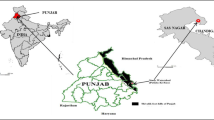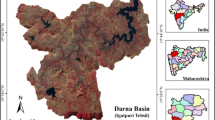Abstract
The Diyung river descends in Nagaon district of Assam. After its confluence with main channel Kopili it causes enormous losses to life and property due to floods. Appropriate watershed treatment measures are, therefore, required for moderating the flood damage. In the present study landscape information viz., the hypsometric integral has been analysed. The Diyung watershed has been subdivided into 23 sub-watersheds for hypsometric analysis. The hypsometric integral for the entire Diyung watershed ranged from 0.14 to 0.56. According to the present study there are two stages of geologic/geomorphologic development, namely equilibrium stage and monadnock stage. The hypsometric integral indicates that surface runoff is the dominant process. Although static, the topographic characteristics indicate response of watershed to various natural phenomenon and dominant processes such as runoff and erosion. Based on the intensity of the processes sub-watershed can be prioritized for taking up appropriate conservation measures. The study also highlights the use of hypsometric integral for prioritizing watershed for planning engineering measures to mitigate the impact.
Similar content being viewed by others
References
Dabral, P.P., Baithuri, N. and Pandey, A. (2008) Soil erosion assessment in a hilly catchment of north eastern India using USLE, GIS and remote sensing. Jour. Water Resour. Mgmt., v.22, pp.1783–1798.
Dowling, T.I., Richarson, D.P., O’Sullivan, A., Summerell, G.K., and Walker, J. (1998) Application of hypsometric integral and other terrain based indicators of catchment health: A preliminary analysis. CSIRO Land and Water, Canberra, Technical Report20/98, April 1998. pp.49.
GoA. (2004) Economic Survey of Assam. Published by Government of Assam. Chapter VIII, 34–37.
Gossain, A.K., Rao, S. and Ray, D.B. (2003) Vulnerability assessment of climate change impact on Indian water resources using the SWAT model. In: Proc. 3rd Internat. SWAT Conf. organized by Swiss Federal Institute for Environmental and Science and Technology, Switzerland and SWAT team at Zurich, Switzerland during 11–15th July, pp.231–240.
GSI (2009) Geology and Mineral resources of Assam. Geol. Surv. India, Misc. Publi., No. 30 Part IV, v.2(i) Assam, 44p.
GSI (2011) Geology and Mineral resources of Manipur, Mizoram, Nagaland and Tripura. Geol. Surv. India, Misc. Publi., No. 30 Part IV, v.1(ii), 103p.
Hasbargen, L.E. (2003) Erosion in steady state drainage basin. Unpublished PhD thesis, submitted to the Faculty of Graduate School of the University of Minnesota, 224p.
Hossain, A.N.H.A. (2003) Integrated Flood Management Case Study Bangladesh: Flood Management, Report of WMO/GWP Associated Program on Flood Management, pp 14.
Hurtrez, J.E., Sol, C. and Lucazeau, F. (1999) Effect of drainage area on hypsometry from analysis of small scale drainage basins in the Siwalik Hills (Central Nepal). Earth Surface Processes and Landforms, v.24(9), pp.799–808.
Lasanta, T., Begueria, S. and Garcia-ruiz, J.M. (2006) Geomorphic and Hydrological Effects of Traditional Shifting Agriculture in a Mediterranean Mountain Area, Central Spanish Pyrenees. Journal of Mountain Research and Development, v.26(2), pp.146–152.
Lin, Z and Oguchi, T. (2004) Drainage density, slope angle and relative basin position in Japanese bare lands from high resolution DEMs. Geomorphology, v.63(3-4), pp.159–173.
MB, (2011) The Hydrological Impacts of Deforestation — A Case from the Mekong Basin. http://wiki.mekonginfo.org/index.php. Accessed on 21.06.2011.
Moglen, G.E. and Bras, R.L. (1995) The effect of spatial heterogeneities on geomorphic expression in a model of basin evolution. Water Resour. Res., v.31(10), pp.2613–2623.
MoWR. (1998) Water Resources Development in India (1947–1997), Ministry of Water Resources, Government of India.
Pike, R.J. and Wilson, S.E. (1971) Elevation-relief Ratio, Hypsometric Integral and Geomorphic Area-Altitude Analysis. Geol. Soc. London, v.157, pp.303–316.
Ritter, D.F., Kochel, R.C. and Miller, 1.R. (2002) Process Geomorphology. McGraw Hill, Boston.
Sarangi, A, Bhattacharya, Ak., Singh, A. and Singh, A.K. (2001) Use of Geographic Information System (GIS) in assessing the erosion status of watersheds. Indian Jour. Soil Conserv., v.29, pp.190–195.
Schumm, S.A. (1956) Evolution of drainage systems and slopes in badlands at Perth Amboy, New Jersey. Geol. Soc. Amer. Bull., v.67, pp.597–646.
Singh, O. and Sarangi, A. (2008). Hypsometric analysis of the lesser Himalayan watershed using geographical information system. Indian Jour. Soil Conserv., v.36(3), pp.148–154.
Singh, T. (2008) Hypsometric analysis of watersheds developed on actively deforming Mohand anticlinal ridge, NW Himalaya. Geocarto Internat., v.23(6), pp.417–427.
Strahler, A.N. (1952) Hypsometric (Areaaltitude) analysis of erosional topography. Geol. Soc. Amer. Bull., v.63, pp.1117–1142.
Strahler, A.N. (1954) Statistical analysis in geomorphic research. Jour. Geol., v.62, pp.1–25.
Strahler, A.N. (1957) Quantitative analysis of watershed geomorphology, Eos Trans. AGU, v.38(6), pp.913–920.
Tripathi, R.S. and Barik, S.K. (2003) Shifting cultivation in North East India. In: B.P. Bhatt, K.M. Bujarbaruah, Y.P. Sharma and Patiram (Eds.), Proc. Approaches for increasing agricultural productivity in hill and mountain eco system. ICAR Research Complex for NEH region, Umiam, Meghalaya, pp.317–322.
Vivoni, E.R., Di Benedetto, F, Grimaldi, S. and Eltahir, E.A.B. (2008) Hypsometric control on surface and subsurface runoff. Water Resour. Res., v.44, W12502, doi: 10.1029/2008WR006931.
Author information
Authors and Affiliations
Corresponding author
Rights and permissions
About this article
Cite this article
Kusre, B.C. Hypsometric analysis and watershed management of Diyung watershed in north eastern India. J Geol Soc India 82, 262–270 (2013). https://doi.org/10.1007/s12594-013-0148-x
Received:
Accepted:
Published:
Issue Date:
DOI: https://doi.org/10.1007/s12594-013-0148-x




